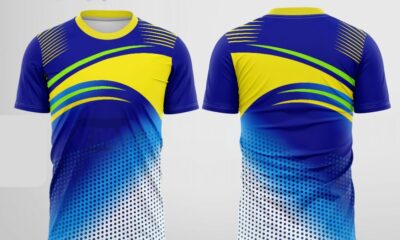FASHION
Understanding the Importance of a Leather Apron in Blacksmithing

In the intricate dance of metal against fire, blacksmithing emerges as both an art form and a practical craft. Within this dynamic realm, where creativity meets craftsmanship, the importance of protective gear becomes paramount. At the forefront stands the leather apron for blacksmithing, a symbol of tradition, resilience, and dedication. From ancient forges to modern workshops, the leather apron for blacksmithing has stood the test of time, offering steadfast protection against the hazards of the trade. In this comprehensive overview, we delve into the significance of the leather apron for blacksmithing, tracing its evolution, exploring its functionality, and highlighting its indispensable role in the forging process. Join us as we unravel the rich tapestry of history and craftsmanship woven into every stitch of the leather apron for blacksmithing, and discover why it remains an essential tool for blacksmiths around the world.
History of Leather Aprons
The history of leather aprons is a tapestry woven with threads of tradition, necessity, and innovation. Dating back to ancient civilizations, blacksmiths and craftsmen recognized the need for protective garments to shield themselves from the intense heat and flying sparks of the forge. In the early days, aprons were rudimentary coverings crafted from whatever materials were readily available, often little more than layers of cloth or animal hides tied around the waist. However, as metallurgy advanced and the demands of the trade grew more complex, so too did the design and construction of leather aprons. Over time, artisans honed their skills, refining techniques and incorporating new materials to create aprons that offered superior protection and durability. From the humble beginnings of simple leather coverings to the sophisticated garments of today, the evolution of leather aprons mirrors the evolution of blacksmithing itself, embodying a legacy of craftsmanship and ingenuity passed down through generations.
Functionality of Leather Aprons
At its core, the functionality of leather aprons lies in their ability to provide a robust barrier against the hazards of the blacksmithing trade. Crafted from thick, durable hides, these aprons offer unparalleled resistance to heat, sparks, and sharp objects, shielding the wearer’s body from potential burns, cuts, and abrasions. The dense weave of leather fibers forms a formidable barrier, effectively deflecting heat and dispersing sparks, while still allowing for freedom of movement and flexibility in the workshop. Additionally, the natural properties of leather, such as its insulating qualities and ability to conform to the body’s contours over time, further enhance the apron’s functionality, ensuring a comfortable and secure fit for hours of wear.
Types of Leather Used
When it comes to selecting a leather apron, the type of leather used plays a significant role in determining its performance and durability. Cowhide, prized for its strength and resilience, remains a popular choice among blacksmiths for its ability to withstand the rigors of daily use. Its dense fibers and natural oils make it highly resistant to heat and abrasion, ensuring long-lasting protection in the workshop. However, other types of leather, such as goatskin and buffalo hide, offer their own unique advantages. Goatskin, for example, is prized for its softness and flexibility, making it ideal for tasks that require dexterity and precision. Buffalo hide, on the other hand, is known for its exceptional toughness and durability, making it well-suited for heavy-duty applications. By understanding the properties of each type of leather, blacksmiths can make informed decisions when choosing an apron that best suits their needs and preferences.
1. Traditional Full-Length Aprons:
- These aprons provide extensive coverage, protecting the torso, legs, and thighs from heat, sparks, and debris.
- Typically made from thick, durable leather such as cowhide, they offer excellent resistance to abrasion and punctures.
- Ideal for heavy-duty forging and welding tasks where maximum protection is required.
2. Split-Leg Aprons:
- Split-leg aprons feature openings or slits in the front, allowing for greater freedom of movement and flexibility.
- They provide protection for the torso and upper legs while allowing the wearer to move more freely, making them suitable for tasks that require agility and precision.
- Commonly used by blacksmiths who need to move quickly between different workstations or perform intricate detailing work.
3. Bib Aprons:
- Bib aprons cover the chest and torso area, offering protection from sparks and splashes while leaving the legs unobstructed.
- They are often lighter and more comfortable to wear for extended periods, making them suitable for tasks that require frequent bending or kneeling.
- Bib aprons are popular among blacksmiths who prioritize mobility and ventilation without sacrificing protection.
4. Shop Coat Aprons:
- Shop coat aprons resemble traditional coats or jackets, with extended coverage that protects the entire upper body.
- They typically feature multiple pockets and compartments for storing tools and accessories, providing convenience and organization in the workshop.
- Shop coat aprons offer versatility, allowing blacksmiths to wear them over regular clothing for added protection without the need for a separate apron.
5. Cross-Back Aprons:
- Cross-back aprons have straps that crisscross over the back, distributing weight evenly and reducing strain on the shoulders and neck.
- They offer a comfortable and secure fit, making them suitable for long hours of wear in the workshop.
- Cross-back aprons are favored by blacksmiths who prioritize comfort and ergonomic design, especially during extended forging sessions.
6. Customized Aprons:
- Many blacksmiths opt for customized aprons tailored to their specific preferences and requirements.
- Customization options may include personalized embroidery, logos, or additional features such as tool loops and pockets.
- Customized aprons allow blacksmiths to express their individuality and brand their work with a unique identity.
7. Disposable Aprons:
- Disposable aprons are made from lightweight materials such as polyethylene or vinyl and are intended for single-use applications.
- They provide basic protection against splashes and spills but may not offer the same level of durability or heat resistance as leather aprons.
- Disposable aprons are suitable for occasional or temporary tasks where quick cleanup and convenience are prioritized over long-term durability.
Design Features
The design of a leather apron is as crucial to its functionality as the quality of the materials used in its construction. Every aspect of the apron, from its length and coverage to the arrangement of pockets and straps, is carefully considered to maximize protection and comfort in the workshop. Longer aprons, for example, provide greater coverage for the legs and lower body, minimizing the risk of burns and injuries in areas prone to exposure. Adjustable straps ensure a snug yet comfortable fit, allowing for easy movement and flexibility while working. Additionally, strategically placed pockets and loops offer convenient storage for tools and accessories, keeping essential items within reach at all times. By incorporating these design features, leather aprons not only provide superior protection but also enhance efficiency and productivity in the blacksmithing trade.
Customization Options
In addition to their practical functionality, leather aprons offer ample opportunities for customization and personalization. Many blacksmiths choose to adorn their aprons with logos, names, or intricate designs, transforming them into unique works of art that reflect their individual style and identity. Whether it’s a simple monogram stitched onto the chest or an elaborate pattern tooled into the leather, these customizations serve as a testament to the wearer’s craftsmanship and creativity. Moreover, manufacturers often offer a range of customization options, allowing blacksmiths to tailor their aprons to suit their specific needs and preferences. Whether it’s adding extra pockets, incorporating tool loops, or adjusting the length and fit, these customizations ensure that every apron is as unique as the craftsman who wears it.
Benefits of Using a Leather Apron
The benefits of wearing a leather apron extend far beyond mere protection in the workshop. In addition to shielding the wearer from heat, sparks, and sharp objects, aprons also convey a sense of professionalism and dedication to the craft. Whether it’s in the confines of a private forge or on the bustling streets of a renaissance fair, a well-worn apron serves as a symbol of expertise and commitment, earning respect from peers and clients alike. Furthermore, by providing a barrier against the elements and potential hazards, aprons enable blacksmiths to work with confidence and peace of mind, allowing them to focus on honing their skills and creating works of art that stand the test of time.
Maintenance and Care
Proper maintenance and care are essential to prolonging the lifespan of a leather apron and ensuring its continued effectiveness in the workshop. Regular cleaning with mild soap and water helps to remove dirt, grease, and other contaminants that can accumulate during use. Conditioning the leather with a high-quality leather oil or balm replenishes lost moisture and restores suppleness, preventing the leather from drying out and cracking over time. Additionally, storing the apron in a cool, dry place away from direct sunlight helps to prevent fading and deterioration, preserving its integrity for years to come. By following these simple maintenance tips, blacksmiths can ensure that their leather aprons remain in top condition, providing reliable protection and comfort throughout their lifespan.
Alternatives to Leather Aprons
While leather aprons remain the gold standard in the world of blacksmithing, there are alternatives available for those seeking different options. Canvas aprons, for example, offer lightweight comfort and breathability, making them ideal for tasks that require extended periods of wear. However, they may lack the same level of heat resistance and durability as their leather counterparts, making them less suitable for high-temperature applications. Similarly, synthetic materials such as nylon or polyester offer water-resistant properties and easy cleaning, but they may not provide the same level of protection against heat and sparks. By weighing the pros and cons of each option, blacksmiths can make informed decisions based on their specific needs and preferences.
Famous Blacksmiths and Their Aprons
Throughout history, legendary blacksmiths have left an indelible mark on the craft, often accompanied by their iconic aprons. From mythical figures of folklore to modern-day artisans, these individuals have wielded hammer and anvil with skill and determination, their aprons serving as both practical attire and symbolic emblems of their trade. Whether it’s the legendary Norse god Thor with his enchanted apron of strength or the renowned Japanese swordsmiths clad in traditional kimonos, the image of the blacksmith and their apron is deeply ingrained in the collective consciousness of cultures around the world. Today, contemporary blacksmiths continue to honor this tradition, wearing their aprons with pride as they carry on the legacy of those who came before them.
Innovations in Apron Design
As technology continues to advance, so too does the design and construction of leather aprons. In recent years, there has been a surge of innovation in apron design, with manufacturers incorporating new materials and features to enhance comfort, protection, and functionality. Advanced materials such as Kevlar and carbon fiber offer increased resistance to heat and abrasion, providing an extra layer of protection for blacksmiths working in extreme conditions. Ergonomic padding and adjustable straps ensure a comfortable fit for extended periods of wear, reducing fatigue and strain on the body. Furthermore, integrated cooling systems and moisture-wicking fabrics help to regulate body temperature and keep blacksmiths comfortable and focused on their work. By embracing these innovations, blacksmiths can enjoy enhanced safety and performance in the workshop, allowing them to push the boundaries of their craft with confidence and creativity.
The Black Leather Apron: Symbol of Protection
In the realm of blacksmithing, where precision meets intensity, the black leather apron stands as an iconic symbol of protection and craftsmanship. Crafted from durable hides and dyed in the timeless shade of black, this essential piece of gear serves as a steadfast barrier against the searing heat and flying sparks of the forge. Beyond its practical function, the black leather apron embodies tradition and dedication, weaving a narrative of resilience and skill in the age-old art of metalworking. From ancient forges to modern workshops, its presence remains indispensable, offering blacksmiths a sense of security and identity as they ply their craft.
Cultural Significance
Beyond its practical utility, the leather apron holds deep cultural significance within the world of blacksmithing. Symbolizing craftsmanship, tradition, and the spirit of innovation, it occupies a revered place in the collective consciousness of artisans and enthusiasts alike. Whether it’s depicted in historical texts, celebrated in folklore, or immortalized in works of art, the leather apron serves as a timeless emblem of the blacksmithing ethos. Moreover, its presence in popular culture, from movies and television shows to literature and music, further cements its status as a cultural icon, inspiring admiration and reverence for the ancient craft of metalworking. By embracing the cultural significance of the leather apron, blacksmiths pay homage to the rich history and heritage of their craft, ensuring that its legacy endures for generations to come.
Common Misconceptions
Despite its storied history and undeniable utility, leather aprons are not immune to misconceptions and myths. From assumptions about their weight and discomfort to doubts regarding their effectiveness, these misconceptions often arise from misinformation or lack of firsthand experience. One common misconception is that leather aprons are heavy and cumbersome to wear, leading some to believe that they may impede movement or cause discomfort during prolonged use. However, modern apron designs incorporate lightweight materials and ergonomic features that ensure a comfortable fit and unrestricted mobility in the workshop. Another misconception is that leather aprons are only suitable for professional blacksmiths or industrial settings, overlooking their versatility and practicality for hobbyists and enthusiasts alike. By dispelling these myths and providing accurate information, we can foster a deeper understanding and appreciation for the role of leather aprons in blacksmithing, ensuring that they continue to be valued as essential tools of the trade.
Conclusion
In conclusion, the leather apron stands as an indispensable tool in the arsenal of every blacksmith, embodying a legacy of craftsmanship, durability, and protection. From its humble origins to its modern innovations, it continues to serve as a symbol of tradition and excellence in the ever-evolving landscape of blacksmithing. By understanding its importance and embracing its utility, we honor the legacy of those who came before us while forging new paths of innovation and creativity in the art of metalworking. Whether it’s protecting against heat and sparks in the workshop or conveying a sense of professionalism and dedication to the craft, the leather apron remains an enduring symbol of the blacksmithing ethos, inspiring admiration and reverence for centuries to come.
FAQs
- Are leather aprons suitable for all types of blacksmithing tasks?
– Leather aprons are versatile enough to provide protection for a wide range of tasks, from forging to grinding and welding.
- How do I know which type of leather apron is right for me?
– Consider factors such as the type of work you’ll be doing, your comfort preferences, and your budget when choosing a leather apron.
- Can leather aprons be repaired if they’re damaged?
– Yes, minor damage such as tears or abrasions can often be repaired with leather patches or stitching.
- Are there any safety precautions I should take when wearing a leather apron?
– Always ensure that your apron is properly secured and fits comfortably to avoid any accidents or injuries in the workshop.
- Can I wash my leather apron in a washing machine?
– It’s generally not recommended to machine wash leather aprons, as this can cause damage to the leather. Instead, hand washing with mild soap is preferable.
FASHION
Upgrade Your Wardrobe with Cherrykitten Fashion Today

Cherrykitten Fashion has become a go-to destination for style enthusiasts looking to upgrade their wardrobe with fun, trendy, and versatile pieces. Among the collection’s most popular items are y2k shirts and baby tees, which bring together the nostalgic charm of early-2000s fashion with modern design sensibilities. These staples are perfect for creating casual yet stylish outfits, layering with other clothing items, or making a bold fashion statement. With Cherrykitten Fashion, refreshing your wardrobe has never been easier, allowing you to experiment with new styles while keeping comfort and individuality in mind.
The beauty of Cherrykitten Fashion lies in its adaptability. Y2k shirts and baby tees can be styled with jeans, skirts, coordinated sets, or layered under dresses and jackets to create unique outfits suitable for any occasion. Whether updating your everyday essentials or seeking statement pieces for special events, Cherrykitten provides options that fit every style preference and personality.
Y2K Shirts: Bold, Playful, and Trendy
Y2k shirts have made a massive comeback, and Cherrykitten’s collection features a wide variety of designs that capture the early-2000s aesthetic. Characterized by cropped fits, vibrant colors, and fun graphics, these shirts are a perfect way to incorporate a retro vibe into a modern wardrobe.
Pairing y2k shirts with high-waisted pants, skirts, or shorts instantly elevates an outfit, making it trendy without appearing overdone. These shirts are also perfect for layering, whether under oversized jackets, cardigans, or slip dresses, adding depth and dimension to your look. Cherrykitten ensures that each y2k shirt combines quality and comfort, making them a wardrobe essential for fashion-forward shoppers.
Baby Tees: Flirty and Versatile
Baby tees are another staple in the Cherrykitten Fashion collection. Known for their cropped, fitted silhouette, these tops offer a flirty and youthful aesthetic that works well for everyday wear or special occasions. Baby tees are ideal for pairing with high-waisted jeans, skirts, shorts, or coordinated sets, giving you multiple styling options with just one piece.
Cherrykitten offers baby tees in an array of colors, patterns, and designs to suit various personal styles. They are perfect for layering under jackets, cardigans, or even slip dresses to create trendy, multi-dimensional outfits. Baby tees provide flexibility, comfort, and playful charm, making them a must-have for anyone looking to upgrade their wardrobe.
Coordinated Sets for Effortless Style
Cherrykitten Fashion also features coordinated sets designed to make outfit creation simple and stylish. These sets typically pair a matching top—often a y2k shirt or baby tee—with a skirt, shorts, or pants, creating a cohesive and fashionable look.
Coordinated sets are perfect for casual outings, social media photos, or weekend adventures. They allow you to achieve a polished, put-together outfit without spending hours mixing and matching. Cherrykitten ensures that each set balances comfort and style, making them practical yet trendy wardrobe additions.
Dresses and Statement Pieces
In addition to tops and coordinated sets, Cherrykitten offers dresses and statement pieces that complement the overall collection. From playful, bold prints to pastel, soft girl-inspired designs, these pieces add variety and dimension to your wardrobe. Dresses can be layered with y2k shirts or baby tees for unique, layered looks, while statement pieces such as jackets or skirts allow for mix-and-match creativity.
Cherrykitten’s designs ensure that every piece works harmoniously with others in the collection, enabling you to create versatile, stylish outfits without the hassle of complicated styling.
Seasonal Fashion Flexibility
Cherrykitten Fashion is designed to adapt to different seasons, making it easy to refresh your wardrobe year-round. During warmer months, y2k shirts and baby tees can be paired with skirts, shorts, or lightweight pants for casual, stylish looks. In cooler months, these tops can be layered under jackets, cardigans, or matching sets, ensuring comfort and warmth while maintaining a trendy aesthetic.
The ability to mix and match pieces allows shoppers to create seasonal outfits that are both fashionable and functional. Cherrykitten’s versatile designs make it easy to embrace new trends without overhauling your entire wardrobe.
Styling Tips for Upgraded Wardrobe Looks
Cherrykitten Fashion provides a wide range of styling options, allowing you to experiment and express your personality. Pair baby tees with pleated skirts and sneakers for a soft, playful look, or layer a y2k shirt under a slip dress for a trendy, layered outfit. Accessories like hair clips, layered necklaces, mini backpacks, and statement shoes can complete your ensemble and elevate your style.
Experimenting with textures, prints, and layering allows you to create unique, standout outfits using Cherrykitten pieces. Whether your style is soft girl, retro, streetwear, or a mix of aesthetics, the collection provides endless opportunities for creativity.
Comfort and Quality
A standout feature of Cherrykitten Fashion is the focus on comfort and quality. Soft fabrics, thoughtful cuts, and inclusive sizing ensure that y2k shirts, baby tees, and coordinated sets are comfortable for all-day wear. This emphasis on wearability means that upgrading your wardrobe does not come at the cost of practicality, allowing you to look fashionable while feeling confident.
The combination of style and comfort makes Cherrykitten Fashion ideal for school, work, social events, or casual outings, ensuring that every piece fits seamlessly into your lifestyle.
Affordable Fashion for Everyone
Cherrykitten Fashion offers stylish, high-quality clothing at accessible prices, making it easy for shoppers to explore new trends without overspending. By providing a range of designs, colors, and patterns, the brand allows fashion enthusiasts to experiment and express themselves freely. Affordable pieces like y2k shirts and baby tees encourage shoppers to build a versatile, stylish wardrobe without breaking the bank.
Shop Cherrykitten Online
Shopping Cherrykitten online is simple and convenient. The website features clear product images, detailed descriptions, and easy navigation, allowing shoppers to explore y2k shirts, baby tees, coordinated sets, dresses, and accessories. Frequent updates ensure that the latest trends and styling inspiration are always available.
Whether you are upgrading your wardrobe for a new season, creating content for social media, or simply refreshing your everyday style, Cherrykitten Fashion provides a curated selection of trendy pieces that make styling effortless and enjoyable.
Conclusion: Upgrade Your Wardrobe with Cherrykitten
Cherrykitten Fashion offers a wide variety of stylish, versatile, and playful pieces that allow shoppers to upgrade their wardrobe with ease. Featuring y2k shirts, baby tees, coordinated sets, dresses, and statement pieces, the brand ensures that every outfit is fashionable, comfortable, and adaptable. With affordable prices, quality fabrics, and creative designs, Cherrykitten makes it simple to embrace current trends, express individuality, and build a wardrobe full of trendy, must-have pieces. Shop Cherrykitten today to explore fashion that combines style, comfort, and personality.
FASHION
Top Unique Character T-Shirts Every Fan and Collector Must Have

Character T-shirts have become more than just wardrobe essentials—they are treasured pieces for fans, collectors, and pop culture enthusiasts. Whether inspired by movies, games, anime, science icons, or nostalgic cartoons, these shirts allow people to express their passion in a stylish and meaningful way. Today, unique character tees are considered wearable art, cherished by both casual fans and serious collectors. In this guide, we explore why these pieces hold such value, what styles stand out, and which types of geek t shirt deserve a place in your collection.
Why Character T-Shirts Are So Popular Among Fans
Character T-shirts allow fans to showcase the stories, heroes, and universes they love. They offer a simple yet powerful way to express identity—whether you’re inspired by a superhero, a game protagonist, or a cartoon character from childhood. These shirts also spark instant recognition among others who share similar interests, often creating connections and conversations. For collectors, character tees serve as unique memorabilia, carrying emotional and nostalgic value that goes far beyond their price.
What Makes a Character T-Shirt “Unique”?
Not all character tees are created equal. A unique T-shirt stands out due to one or more of the following qualities:
- Limited Edition Prints – Designs released exclusively for events, anniversaries, or collaborations.
- Artistic Illustrations – Hand-drawn, redesigned, or rare artwork you won’t find in mainstream stores.
- Mash-Up Concepts – Characters from different universes creatively blended into one masterpiece.
- Vintage or Retro Style – Old-school artwork, 8-bit graphics, or retro color palettes.
- Minimalist Symbolic Designs – Subtle icons or silhouettes that fans instantly recognize.
Collectors especially seek these unique styles because they represent creativity, rarity, and personal connection.
Must-Have Character T-Shirts for Every Fan and Collector
1. Classic Superhero Character Tees
Superhero-themed shirts never go out of style. Whether it’s a bold illustration of your favorite hero or a subtle logo design, these tees are staples for fans of comic universes. Limited edition artwork or crossover hero designs are especially sought after by collectors.
2. Retro Video Game Character T-Shirts
Fans of classic gaming love 8-bit or pixel-art character tees. Mario, Sonic, Zelda, Pac-Man, and other retro icons continue to dominate nostalgic collections. Modern remixes of old characters also create a blend of nostalgia and freshness.
3. Anime and Manga Character Shirts
Anime-inspired character tees are among the most expressive and colorful options. Detailed art prints featuring protagonists, villains, or iconic scenes make these shirts a must for anime fans. Limited drops from popular series often sell out quickly and become prized collector items.
4. Cartoon and Animated Character T-Shirts
From childhood favorites to modern animated icons, cartoon character tees carry a strong emotional appeal. Fans adore shirts that remind them of classic episodes, humorous moments, or beloved childhood memories.
5. Nerd Culture & Science Character Tees
Collectors who appreciate science, discovery, and intellect love character designs based on scientists, inventors, and educational icons. A clever nerd shirt featuring an astronaut, mathematician, or scientific symbol adds a smart twist to everyday fashion.
6. Minimalist and Symbolic Character Shirts
These designs don’t always show the full character, but instead use symbols, silhouettes, or shapes that fans immediately recognize. Minimalist character tees are perfect for people who prefer subtle and stylish designs while still celebrating their fandom.
Why Collectors Value High-Quality Character Tees
For collectors, quality matters just as much as design. A well-made character T-shirt ensures the artwork remains vivid, the fabric feels comfortable, and the shirt retains its shape even after multiple washes. High-quality printing—screen printing for bold graphics or digital printing for detailed art—is essential to keep the design looking sharp. Premium fabrics also offer durability, which is crucial for those who plan to keep or display their character tees long-term.
How to Style Character T-Shirts for Everyday Wear
One of the best things about character tees is how easy they are to style. Here are a few simple ideas:
- Casual Look: Pair your favorite character tee with jeans and sneakers.
- Streetwear Style: Opt for oversized character T-shirts, combined with joggers or cargo pants.
- Layered Outfit: Wear your character tee under an open flannel, denim jacket, or hoodie.
- Smart Casual: Match a minimalist character shirt with a blazer for a stylish yet subtle fandom look.
These versatile shirts work year-round and suit almost any personal style.
Character T-Shirts: The Perfect Gift for Fans
If you’re searching for the ideal gift for a fan or collector, a character T-shirt is a perfect choice. You can choose a design based on their favorite hero, game, anime, or scientific figure. These shirts are thoughtful, meaningful, and highly appreciated—especially when you pick a design that matches the receiver’s taste.
Conclusion
Unique character T-shirts are more than just printed shirts—they represent stories, emotions, and passions that fans deeply connect with. Whether you are a gamer, movie lover, anime fan, or collector of geek and nerd culture, these tees help you express your identity in a fun and stylish way. With endless styles, themes, and artistic options, there’s always a new design waiting to become your next favorite.
If you love collecting or expressing your fandom through fashion, character T-shirts are a must-have addition to your wardrobe and collection.
FASHION
Premium Cotton Hoodies and Shirts Tokyo-Tiger Style

Japanese t shirts have become a symbol of comfort, quality, and unique cultural style in modern streetwear, and Tokyo-Tiger builds on this tradition with its Premium Cotton Hoodies and Shirts collection. Designed for both everyday wear and expressive urban fashion, each piece pairs effortlessly with a Japan t shirt for versatile layering options. Whether you’re exploring city streets, attending social gatherings, or simply seeking stylish comfort, Tokyo-Tiger’s hoodies and shirts deliver high-quality fabrics, bold designs, and timeless Japanese-inspired aesthetics. With a blend of classic cotton materials and contemporary streetwear trends, this collection ensures that every outfit is both comfortable and visually striking.
High-Quality Cotton for Ultimate Comfort
The foundation of Tokyo-Tiger’s collection is premium cotton, carefully selected for its softness, breathability, and long-lasting durability. Japanese t shirts and Japan t shirt layers complement these hoodies and shirts perfectly, allowing for flexible styling options that suit any season. Lightweight cotton ensures comfort during warmer weather, while the hoodies provide warmth and protection during cooler days. Reinforced stitching and durable construction maintain the shape and integrity of each piece, making these hoodies and shirts reliable staples in any wardrobe.
Striking Japanese-Inspired Designs
Tokyo-Tiger’s Premium Cotton Hoodies and Shirts are celebrated for their bold, Japanese-inspired graphics. From traditional motifs and calligraphy to anime and manga references, each piece is designed to make a fashion statement while celebrating Japanese culture. Layering a Japanese t shirt or a Japan t shirt beneath a hoodie or shirt adds depth and versatility to your outfit, creating looks that are both unique and expressive. Minimalist designs cater to those seeking subtle elegance, while vibrant, detailed prints appeal to fans of streetwear and pop culture alike.
Versatile Styling Options
One of the strengths of Tokyo-Tiger’s collection is its adaptability. Shirts can be worn casually with jeans, shorts, or joggers, while hoodies provide layered warmth over Japanese t shirts or a Japan t shirt for a complete streetwear look. Relaxed and oversized fits create a modern, urban silhouette, while fitted styles offer a cleaner, tailored appearance. These pieces are designed to suit a variety of occasions—from casual outings and city adventures to social meetups and creative events—making them indispensable for anyone seeking practical yet fashionable streetwear.
Express Your Individuality Through Fashion
Streetwear is a form of self-expression, and Tokyo-Tiger’s Premium Cotton Hoodies and Shirts allow wearers to showcase their personality and cultural interests. Fans of Japanese pop culture, manga, anime, and modern art can select pieces that reflect their style. Layering Japanese t shirts or a Japan t shirt under a hoodie or shirt adds visual interest and creative flair, enabling wearers to craft outfits that stand out. Whether exploring urban spaces, attending conventions, or simply enjoying everyday activities, these pieces provide the perfect canvas for personal expression.
Limited Edition and Exclusive Pieces
Tokyo-Tiger frequently releases limited-edition hoodies and shirts featuring exclusive Japanese-inspired artwork. These designs appeal to collectors and fashion enthusiasts seeking distinctive wardrobe items. Pairing limited-edition pieces with Japanese t shirts or a Japan t shirt enhances layered streetwear outfits and ensures unique, memorable looks. The combination of high-quality materials, bold graphics, and exclusivity makes these items highly sought after for fashion-forward individuals who value originality and cultural inspiration in their clothing.
Durability Meets Style
Durability is a key feature of Tokyo-Tiger’s Premium Cotton Hoodies and Shirts. Premium fabrics, reinforced stitching, and professional-grade printing ensure that each piece maintains its shape, color, and design over time. Japanese t shirts and Japan t shirt layers pair seamlessly with these hoodies and shirts, creating long-lasting, stylish outfits suitable for everyday wear. This balance of durability and aesthetic appeal makes the collection ideal for streetwear enthusiasts seeking both functional and fashionable clothing.
Celebrate Japanese Culture in Everyday Fashion
Tokyo-Tiger’s collection allows wearers to incorporate Japanese culture into their everyday wardrobe. From bold graphics to anime and manga-inspired designs, the pieces reflect the rich artistic heritage of Japan while staying relevant to modern streetwear trends. Layering Japanese t shirts or a Japan t shirt under hoodies and shirts adds visual depth and versatility, creating outfits that are culturally inspired, stylish, and comfortable. This makes the collection ideal for anyone looking to combine fashion, comfort, and cultural appreciation in one cohesive streetwear look.
Conclusion: Elevate Your Wardrobe with Tokyo-Tiger
The Tokyo-Tiger Premium Cotton Hoodies and Shirts collection offers the perfect combination of comfort, durability, and Japanese-inspired style. With high-quality fabrics, bold designs, and versatile layering options, these Japanese t shirts and Japan t shirt-inspired pieces provide endless possibilities for creating expressive streetwear outfits. Whether worn alone or layered for a dynamic urban look, Tokyo-Tiger hoodies and shirts allow wearers to express individuality, celebrate Japanese culture, and stay comfortable in any setting. Explore the collection to elevate your wardrobe with high-quality, culturally inspired streetwear essentials that seamlessly combine fashion, comfort, and personality.

 Cartoon5 months ago
Cartoon5 months agoUnlocking the Potential of Nekopoi.care: A Comprehensive Guide

 Game2 years ago
Game2 years agoExploring Aopickleballthietke.com: Your Ultimate Pickleball Destination

 BUSINESS2 years ago
BUSINESS2 years agoUnraveling the Mystery of 405 Howard Street San Francisco charge on Credit Card

 BUSINESS5 months ago
BUSINESS5 months agoWhat Companies Are In The Consumer Services Field

 HOME IMPROVEMENT2 years ago
HOME IMPROVEMENT2 years agoVtrahe vs. Other Platforms: Which One Reigns Supreme?

 ENTERTAINMENT1 year ago
ENTERTAINMENT1 year agoUnderstanding Bunkr Album: A Comprehensive Guide

 ENTERTAINMENT2 years ago
ENTERTAINMENT2 years agoThe Ultimate Guide to MP3Juices: Free Music Download

 TECHNOLOGY2 years ago
TECHNOLOGY2 years agoThe Guide to Using Anon Vault for Secure Data Storage
















